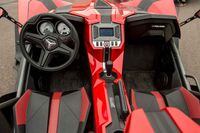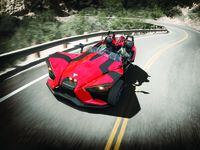Seems a simple question, doesn’t it? A motorcycle by the classic definition is a single-track vehicle that must lean to turn. Even I can keep that straight.
And yet our sport has historically taken in offshoots as its own, welcomed them into the family. Sidecars, for example. We embrace the sidecar in part because it begins with a motorcycle but also because good ones are a total hoot to ride. Like a carnival you take with you. Everyone smiles riding a sidecar, except when misjudging a decreasing-radius right-hander.
Trikes and Spyders I'm a little less in love with because they seem, to me, to embody the risks of motorcycling without the benefits I most enjoy: the delicious interplay of bank angle and power, a balancing act of forward motion. Trikes you kinda plow along, exchanging rolling motions for lateral forces. I've ridden trikes just enough to be dangerous, and I realize there are ways to compensate for some of the more prominent shortcomings—like the fact that you're laying down three contact patches across the lane, so avoiding junk in the road takes extra effort. But those maneuvers are not second nature to me.
Don’t take me wrong. I have complete respect for those who choose a trike (two wheels at the rear) or a Spyder (two at the front) over a motorcycle. I get that they’re overcoming a physical obstacle that prevents them from riding or overcoming the fear of falling over by making it (almost) impossible. I also appreciate that these riders are in our world of dealerships, buying helmets and jackets and boots, which raises the tide for everyone. I wave at riders on trikes and Spyders, sometimes to their surprise.
And now we have the Polaris Slingshot . Right up front, the company warns—no doubt at the behest of sweaty-palmed lawyers on staff—that the Slingshot is not an automobile; it's a three-wheeled motorcycle. We often joke that some bikes are big and heavy enough to be cars, but the Slingshot actually is. Its curb weight is listed as 1,743 pounds, wheelbase as 105 inches, and the engine is a 2,384cc auto-based inline-four. Between it and the single rear wheel is a five-speed, non-sequential manual transmission. I had a first-generation Mazda Miata, which is by a long shot the most fun cage I've owned, with my beloved Honda CRX Si a close second. Compared to the Slingshot, the early Miata was nearly 16 inches shorter in wheelbase, had just a 1.6-liter engine, and weighed a remarkable 2,100 pounds. Like the Miata, the Slingshot has a steering wheel.
So how, exactly, do we get to call the Slingshot a motorcycle? It’s a quirk of vehicle regulations that two- and three-wheelers are considered one in the same, so they’re given much more lax equipment and emissions requirements. No airbags, no mandatory tire-pressure warning systems, no side-impact tests. In a way that’s purer, but you can’t argue that today’s airbag-equipped cars aren’t the safest ever.
I have no doubt that the Slingshot is a complete hoot to drive—it has an impressive power-to-weight ratio and a lot of rubber on the ground. And since it will be sold through Polaris dealers who also service the two-wheel and ATV industry, Slingshot customers will bring money into our economy. That’s always welcome, which is why I’m happy to see Polaris build the thing, just as I’m thrilled to see new riders on trikes even as three-wheelers do not interest me.
Welcome, then, Slingshot drivers. Have fun. Watch out for me in the carpool lane. But, please, don’t even think of calling your car a motorcycle.












/cloudfront-us-east-1.images.arcpublishing.com/octane/GTCXACQGJ5HAPDTGWUQKDEH44E.jpg)
/cloudfront-us-east-1.images.arcpublishing.com/octane/S35YGSEMEZB4BLTDJTSZPF4GLA.jpg)
/cloudfront-us-east-1.images.arcpublishing.com/octane/5UOT6HPX2JFMRJAX6EH45AR4MQ.jpg)
/cloudfront-us-east-1.images.arcpublishing.com/octane/OKWOJWAKP5EP3OACCRRWPCIX2Q.jpg)
/cloudfront-us-east-1.images.arcpublishing.com/octane/2WF3SCE3NFBQXLDNJM7KMXA45E.jpg)
/cloudfront-us-east-1.images.arcpublishing.com/octane/G4MG6OUCJNBSHIS2MVVOTPX65E.jpg)
/cloudfront-us-east-1.images.arcpublishing.com/octane/IIGGWFOTOJGB7DB6DGBXCCMTDY.jpg)
/cloudfront-us-east-1.images.arcpublishing.com/octane/QSTCM6AVEZA5JJBUXNIQ3DSOF4.jpg)
/cloudfront-us-east-1.images.arcpublishing.com/octane/U4I7G625B5DMLF2DVIJDFZVV6M.jpg)
/cloudfront-us-east-1.images.arcpublishing.com/octane/B6XD6LS6IVCQPIU6HXDJSM3FHY.jpg)
/cloudfront-us-east-1.images.arcpublishing.com/octane/ICL63FEDDRDTTMINYICCEYGMDA.jpg)
/cloudfront-us-east-1.images.arcpublishing.com/octane/FCGZHQXRBZFLBAPC5SDIQLVF4I.jpg)
/cloudfront-us-east-1.images.arcpublishing.com/octane/WNOB6LDOIFFHJKPSVIWDYUGOPM.jpg)

/cloudfront-us-east-1.images.arcpublishing.com/octane/X33NU3E525ECRHXLNUJN2FTRKI.jpg)
/cloudfront-us-east-1.images.arcpublishing.com/octane/6KKT5NNL2JAVBOXMZYS5ZO76YA.jpg)
/cloudfront-us-east-1.images.arcpublishing.com/octane/J5RKG5O455GMPGQRF2OG6LRT7A.jpg)
/cloudfront-us-east-1.images.arcpublishing.com/octane/GX2CIZKQVRH2TATDM26KFG2DAE.jpg)
/cloudfront-us-east-1.images.arcpublishing.com/octane/ZWIDYSAKQZHD5BHREMQILXJCGM.jpg)
/cloudfront-us-east-1.images.arcpublishing.com/octane/CYUHJZCTSJCH3MRAQEIKXK7SCQ.jpg)
/cloudfront-us-east-1.images.arcpublishing.com/octane/LKOFINY56FCXJCANJ5M7ZDQUBY.jpg)
/cloudfront-us-east-1.images.arcpublishing.com/octane/4NBPDACMWJH63JQYJVK3QRBDZI.jpg)
/cloudfront-us-east-1.images.arcpublishing.com/octane/KKHQHRR3FJGX7H2IPU6RALMWG4.jpg)
